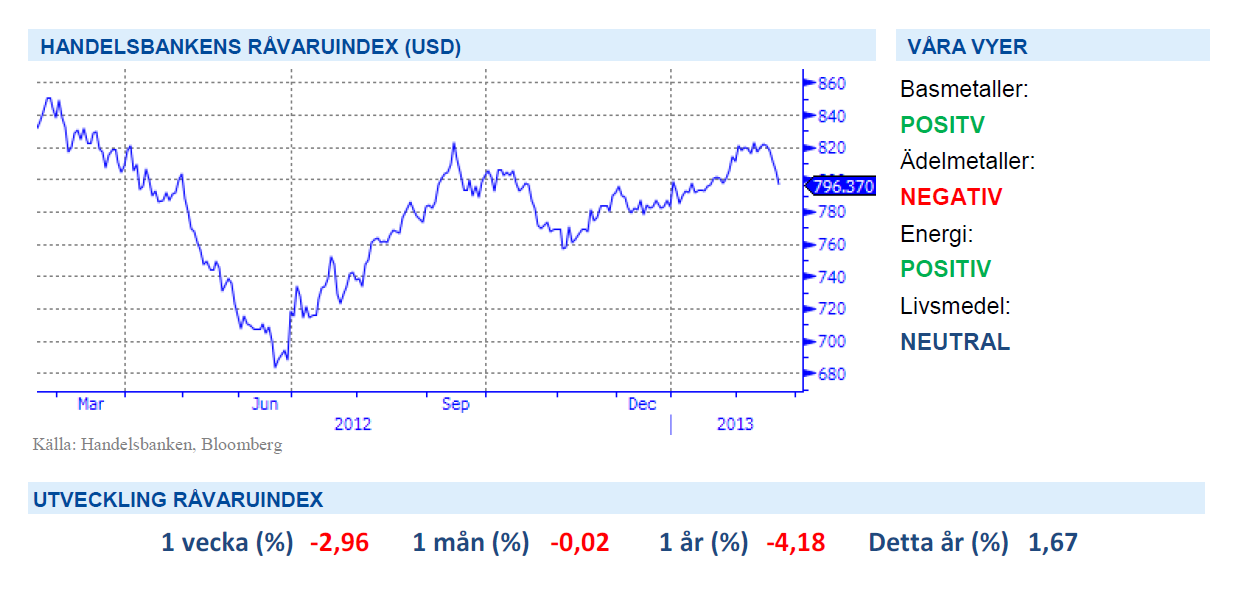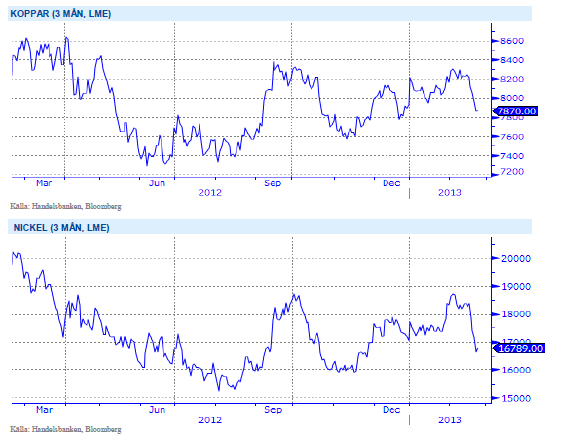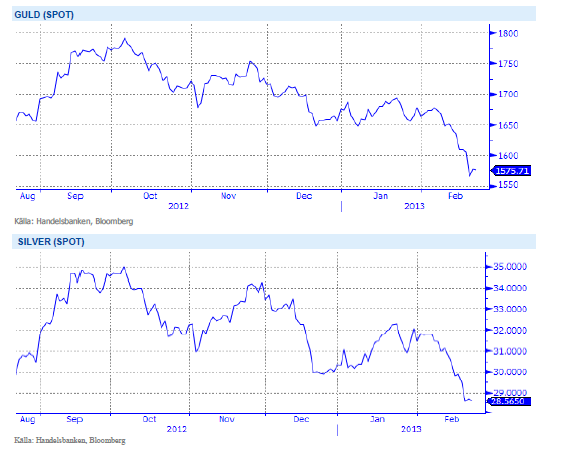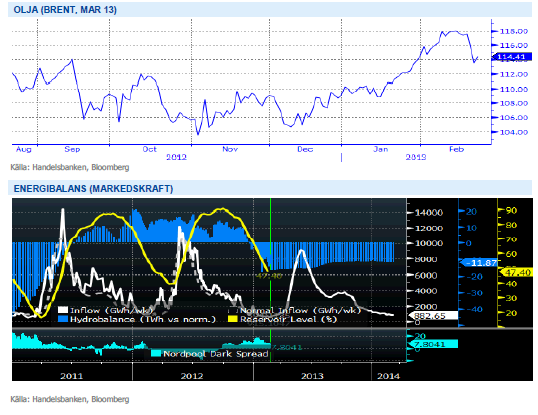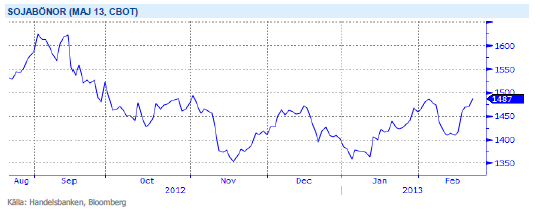Analys
SHB Råvarubrevet 22 februari 2013

 Råvaror allmänt
Råvaror allmänt
Som en blixt från klar himmel
Under veckan kom protokollet från amerikanska centralbankens senaste möte. Det väckte stort rabalder på marknaden när det tydde på oväntat högljudd opposition mot Fedchefen Ben Bernanke. Med räntan nära noll är Bens strategi att köpa obligationer av marknaden (kvantitativa lättnader) i hopp om att detta ska lyfta tillgångspriser, vilket i sin tur bör ge positiva effekter på realekonomin. De senaste årens utveckling har visat att börsen har svårt att klara sig utan centralbanksåtgärder. Därför är veckans kursrörelser på börsen och råvarumarknaden en naturlig ryggmärgsreflex när det mullras bland Fedkollegorna.
Ben ser dock som sin huvuduppgift att inte upprepa Feds misstag från 30-talet då penningpolitiken stramades åt alltför snabbt med utdragen lågkonjunktur som följd. Kursfallen under veckan i basmetaller och energi, drivet av oro för snar avslutning av Feds kvantitativa lättnader bör därför betraktas som köpläge. Att fånga den fallande kniven är alltid svårt men att köpa när det gör ont brukar vara de bästa affärerna.
Annars har veckan präglats av att kinas ledning vill begränsa prisuppgångar i fastigheter och preliminära PMI siffror för Europa (sämre än väntat) och USA (i linje med förväntningar) för februari.
Basmetallerna
Försvunnen riskaptit
I veckan försvann riskaptiten på marknaden efter negativa signaler i protokollet från senaste mötet hos USA:s centralbank, Fed. I protokollet kan man tyda att Fed:s medlemmar tvivlar på hur länge man ska stimulera marknaden med QE3 programmet. Ytterligare negativa signaler kom från Kina där regeringen kommer att vidta åtgärder för att dämpa prisuppgången på fastigheter. Det tolkas som negativt för byggsektorn.
Shanghaibörsen handlades kraftigt ner och värst drabbade var byggbolagen. En våg av negativ spekulation i att detta kommer att minska efterfrågan på de råvaror som används i byggmaterial startade. Basmetaller, järnmalm och stål föll kraftigt under veckan på dessa nyheter och nickel rörde sig som vanligt mest utav basmetallerna. Enbart under torsdagen föll den volatila metallen över 3 % och veckans fall har raderat årets uppgång för basmetallerna. Vi håller kvar vår tro på högre priser på basmetaller och tycker att veckan givit ett bra ”buy on dip” läge.
Trots nedgången under veckan tror vi på högre priser på basmetaller och ser istället möjlighet till ”buy on dip”. Vi tror på: BASMET H
Ädelmetaller
Guldet faller – precis som vi tänkt!
Vår handelsrekommendation att sälja guld från förra fredagen har slagit väl ut. Guld kom snabbt på fall och bröt ner genom de tekniska motstånden på 1650 och 1600. Ytterligare fall blev det efter Feds protokoll då marknaden började prisa ur QE3. Från utskicket i fredags till lägsta nivån under torsdagen hade guldet tappat 4,9 %. Vi fortsätter tro på lägre guldpris men understryker att det är ett attraktivt läge att ta hem en bra vinst på kort tid.
Förutom guldet, som under veckan tappat 2,59 %, har palladium, platinum och silver tappat mellan 4-5 %. Senaste 5 dagarna har vårt index för ädelmetaller fallit med 4,35 %. I Indien, världens största köpare av guld, diskuteras ytterligare en höjning av importskatten från nuvarande 6 % till 8 %. Skatten skulle användas för att minska budgetunderskottet.
Med ljusare konjunktur och potentiellt stigande räntenivåer ser vi ytterligare press på guldet som troligt. Vi tror på: GULD S H
Energi
Läge för ”buy on dip”
Olja har fallit i det negativa sentimentet och ytterligare påspätt av riktigt stora säljordrar i amerikanska WTI oljan som fick Brentoljan med sig nedåt. Produktionen i USA är uppe på högsta nivån sedan 1992 och producerar dryga 7,1 miljoner fat per dag. Vi håller fast vid vår positiva syn trots nedgången och förlitar oss på att den ljusnande konjunkturen kommer ge stöd till oljan framöver. Fallet under veckan är ungefär 3 % och även här ser vi det som ett ”buy on dip” läge för den riskvillige. Försök att fånga kniven!
Elmarknaden handlas oförändrat över veckan med visst stöd från en försvagad energibalans (-11.87 TWh mot normalt se nedan i blått). Väderprognoserna visar normala temperaturer och nederbörd för de kommande 10-dagarna så vi behåller vår neutrala vy. Utsläppsrätterna föll 15 procent efter miljöutskottets röstning kring backloadingförslaget som inte visade på den majoritet man kanske hoppats på. Köpintresset visade sig dock vara ganska stort efter fallet och marknaden handlas åter kring de ca 5 euro vi räknat med. Frågan tas sannolikt vidare till ministerrådet och först efter kvalificerad majoritet där och ett ja i parlamentet kan vi få se ytterligare köpintresse.
Den råvarugrupp som är mest beroende av den globala konjunkturen är Energi och med en starkare konjunktur ser vi positivt på utvecklingen för denna sektor. Vi tror på: ENERGI H
Livsmedel
Kina fortsätter köpa sojabönor
Sojabönor har stigit kraftigt under veckan med fortsatt stark amerikansk export (som vanligt med Kina som största köpare). I Brasilien fortsätter skörden utan större problem, drygt 20 procent av skörden bedöms vara avklarad. USDA beräknar årets kommande amerikanska sojaskörd till rekordhöga 93 miljoner ton, upp 12,9 procent jämfört med förra året. Stark efterfrågan och låga lagernivåer driver upp priserna och på kort sikt är det svårt att se en nedsida för sojan. Faller USDA:s prognos väl in för årets skörd lär vi dock få se klart lägre priser längre fram på året, grödan ska dock först sås och mycket kan hända innan skörd. Priset på majs har fallit under veckan efter nederbörd fallit över de amerikanska majsregionerna – mer önskas men oron har lindrats. Längst ned i de södra delarna av USA har sådden redan startat, i de mer viktiga majsregionerna längre norrut är det dock ännu för kallt och torrt. I Argentina har det fallit lite mer regn, vilket helt klart gynnar den relativt nysådda majsen, nästa vecka ser dock ut att bli lite torrare. Med förbättrad väderlek i både USA och Sydamerika finns all möjlighet för priserna att falla ytterligare. USDA uppskattar nu kommande amerikanska majsskörd till 35 procent över förra året med rekordhöga 369 miljoner ton.
Prisfallet på kaffe sedan mitten av januari har till stor del berott på fortsatt höga lager av både Arabica – och Robustakaffe, dock har lagren av Robusta halverats från rekordåret i juli 2011. Centralamerikas export kan komma att minska 30 procent då svampsjukdomen spridit sig i stora delar av regionen efter kraftiga skyfall och längre perioder av torka. Det återstår att se om välfyllda lager och goda skördar från övriga länder kan komma att täcka bortfallet i Centralamerika. För apelsinjuice har en bakteriesjukdom skadat delar av den amerikanska apelsinodlingen. Man befarar att 10-15 procent av skörden i Florida, världens näst största exportör, kan skadas. Dessutom har temperaturer under normalen orsakat frost i samma område, vilket har fått priset på apelsinjuiceterminen att stiga 10 procent sen årsskiftet.
Även om vår syn på soja, majs och vete fortfarande är att normalt väder ska få priserna att falla så håller vi neutral vy för denna sektor på grund av riskerna för fortsatt torrt väder i USA.
Handelsbankens Råvaruindex
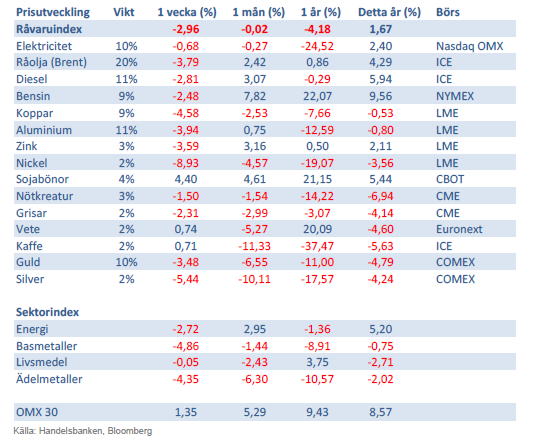
Handelsbankens råvaruindex består av de underliggande indexen för respektive råvara. Vikterna är bestämda till hälften från värdet av global produktion och till hälften från likviditeten i terminskontrakten.
[box]SHB Råvarubrevet är producerat av Handelsbanken och publiceras i samarbete och med tillstånd på Råvarumarknaden.se[/box]
Ansvarsbegränsning
Detta material är producerat av Svenska Handelsbanken AB (publ) i fortsättningen kallad Handelsbanken. De som arbetar med innehållet är inte analytiker och materialet är inte oberoende investeringsanalys. Innehållet är uteslutande avsett för kunder i Sverige. Syftet är att ge en allmän information till Handelsbankens kunder och utgör inte ett personligt investeringsråd eller en personlig rekommendation. Informationen ska inte ensamt utgöra underlag för investeringsbeslut. Kunder bör inhämta råd från sina rådgivare och basera sina investeringsbeslut utifrån egen erfarenhet.
Informationen i materialet kan ändras och också avvika från de åsikter som uttrycks i oberoende investeringsanalyser från Handelsbanken. Informationen grundar sig på allmänt tillgänglig information och är hämtad från källor som bedöms som tillförlitliga, men riktigheten kan inte garanteras och informationen kan vara ofullständig eller nedkortad. Ingen del av förslaget får reproduceras eller distribueras till någon annan person utan att Handelsbanken dessförinnan lämnat sitt skriftliga medgivande. Handelsbanken ansvarar inte för att materialet används på ett sätt som strider mot förbudet mot vidarebefordran eller offentliggörs i strid med bankens regler.
Analys
Tightening fundamentals – bullish inventories from DOE

The latest weekly report from the US DOE showed a substantial drawdown across key petroleum categories, adding more upside potential to the fundamental picture.

Commercial crude inventories (excl. SPR) fell by 5.8 million barrels, bringing total inventories down to 415.1 million barrels. Now sitting 11% below the five-year seasonal norm and placed in the lowest 2015-2022 range (see picture below).
Product inventories also tightened further last week. Gasoline inventories declined by 2.1 million barrels, with reductions seen in both finished gasoline and blending components. Current gasoline levels are about 3% below the five-year average for this time of year.
Among products, the most notable move came in diesel, where inventories dropped by almost 4.1 million barrels, deepening the deficit to around 20% below seasonal norms – continuing to underscore the persistent supply tightness in diesel markets.
The only area of inventory growth was in propane/propylene, which posted a significant 5.1-million-barrel build and now stands 9% above the five-year average.
Total commercial petroleum inventories (crude plus refined products) declined by 4.2 million barrels on the week, reinforcing the overall tightening of US crude and products.


Analys
Bombs to ”ceasefire” in hours – Brent below $70

A classic case of “buy the rumor, sell the news” played out in oil markets, as Brent crude has dropped sharply – down nearly USD 10 per barrel since yesterday evening – following Iran’s retaliatory strike on a U.S. air base in Qatar. The immediate reaction was: “That was it?” The strike followed a carefully calibrated, non-escalatory playbook, avoiding direct threats to energy infrastructure or disruption of shipping through the Strait of Hormuz – thus calming worst-case fears.

After Monday morning’s sharp spike to USD 81.4 per barrel, triggered by the U.S. bombing of Iranian nuclear facilities, oil prices drifted sideways in anticipation of a potential Iranian response. That response came with advance warning and caused limited physical damage. Early this morning, both the U.S. President and Iranian state media announced a ceasefire, effectively placing a lid on the immediate conflict risk – at least for now.
As a result, Brent crude has now fallen by a total of USD 12 from Monday’s peak, currently trading around USD 69 per barrel.
Looking beyond geopolitics, the market will now shift its focus to the upcoming OPEC+ meeting in early July. Saudi Arabia’s decision to increase output earlier this year – despite falling prices – has drawn renewed attention considering recent developments. Some suggest this was a response to U.S. pressure to offset potential Iranian supply losses.
However, consensus is that the move was driven more by internal OPEC+ dynamics. After years of curbing production to support prices, Riyadh had grown frustrated with quota-busting by several members (notably Kazakhstan). With Saudi Arabia cutting up to 2 million barrels per day – roughly 2% of global supply – returns were diminishing, and the risk of losing market share was rising. The production increase is widely seen as an effort to reassert leadership and restore discipline within the group.
That said, the FT recently stated that, the Saudis remain wary of past missteps. In 2018, Riyadh ramped up output at Trump’s request ahead of Iran sanctions, only to see prices collapse when the U.S. granted broad waivers – triggering oversupply. Officials have reportedly made it clear they don’t intend to repeat that mistake.
The recent visit by President Trump to Saudi Arabia, which included agreements on AI, defense, and nuclear cooperation, suggests a broader strategic alignment. This has fueled speculation about a quiet “pump-for-politics” deal behind recent production moves.
Looking ahead, oil prices have now retraced the entire rally sparked by the June 13 Israel–Iran escalation. This retreat provides more political and policy space for both the U.S. and Saudi Arabia. Specifically, it makes it easier for Riyadh to scale back its three recent production hikes of 411,000 barrels each, potentially returning to more moderate increases of 137,000 barrels for August and September.
In short: with no major loss of Iranian supply to the market, OPEC+ – led by Saudi Arabia – no longer needs to compensate for a disruption that hasn’t materialized, especially not to please the U.S. at the cost of its own market strategy. As the Saudis themselves have signaled, they are unlikely to repeat previous mistakes.
Conclusion: With Brent now in the high USD 60s, buying oil looks fundamentally justified. The geopolitical premium has deflated, but tensions between Israel and Iran remain unresolved – and the risk of missteps and renewed escalation still lingers. In fact, even this morning, reports have emerged of renewed missile fire despite the declared “truce.” The path forward may be calmer – but it is far from stable.
Analys
A muted price reaction. Market looks relaxed, but it is still on edge waiting for what Iran will do

Brent crossed the 80-line this morning but quickly fell back assigning limited probability for Iran choosing to close the Strait of Hormuz. Brent traded in a range of USD 70.56 – 79.04/b last week as the market fluctuated between ”Iran wants a deal” and ”US is about to attack Iran”. At the end of the week though, Donald Trump managed to convince markets (and probably also Iran) that he would make a decision within two weeks. I.e. no imminent attack. Previously when when he has talked about ”making a decision within two weeks” he has often ended up doing nothing in the end. The oil market relaxed as a result and the week ended at USD 77.01/b which is just USD 6/b above the year to date average of USD 71/b.

Brent jumped to USD 81.4/b this morning, the highest since mid-January, but then quickly fell back to a current price of USD 78.2/b which is only up 1.5% versus the close on Friday. As such the market is pricing a fairly low probability that Iran will actually close the Strait of Hormuz. Probably because it will hurt Iranian oil exports as well as the global oil market.
It was however all smoke and mirrors. Deception. The US attacked Iran on Saturday. The attack involved 125 warplanes, submarines and surface warships and 14 bunker buster bombs were dropped on Iranian nuclear sites including Fordow, Natanz and Isfahan. In response the Iranian Parliament voted in support of closing the Strait of Hormuz where some 17 mb of crude and products is transported to the global market every day plus significant volumes of LNG. This is however merely an advise to the Supreme leader Ayatollah Ali Khamenei and the Supreme National Security Council which sits with the final and actual decision.
No supply of oil is lost yet. It is about the risk of Iran closing the Strait of Hormuz or not. So far not a single drop of oil supply has been lost to the global market. The price at the moment is all about the assessed risk of loss of supply. Will Iran choose to choke of the Strait of Hormuz or not? That is the big question. It would be painful for US consumers, for Donald Trump’s voter base, for the global economy but also for Iran and its population which relies on oil exports and income from selling oil out of that Strait as well. As such it is not a no-brainer choice for Iran to close the Strait for oil exports. And looking at the il price this morning it is clear that the oil market doesn’t assign a very high probability of it happening. It is however probably well within the capability of Iran to close the Strait off with rockets, mines, air-drones and possibly sea-drones. Just look at how Ukraine has been able to control and damage the Russian Black Sea fleet.
What to do about the highly enriched uranium which has gone missing? While the US and Israel can celebrate their destruction of Iranian nuclear facilities they are also scratching their heads over what to do with the lost Iranian nuclear material. Iran had 408 kg of highly enriched uranium (IAEA). Almost weapons grade. Enough for some 10 nuclear warheads. It seems to have been transported out of Fordow before the attack this weekend.
The market is still on edge. USD 80-something/b seems sensible while we wait. The oil market reaction to this weekend’s events is very muted so far. The market is still on edge awaiting what Iran will do. Because Iran will do something. But what and when? An oil price of 80-something seems like a sensible level until something do happen.
-

 Nyheter4 veckor sedan
Nyheter4 veckor sedanMahvie Minerals växlar spår – satsar fullt ut på guld
-

 Analys4 veckor sedan
Analys4 veckor sedanA muted price reaction. Market looks relaxed, but it is still on edge waiting for what Iran will do
-

 Nyheter3 veckor sedan
Nyheter3 veckor sedanJonas Lindvall är tillbaka med ett nytt oljebolag, Perthro, som ska börsnoteras
-

 Nyheter3 veckor sedan
Nyheter3 veckor sedanOljan, guldet och marknadens oroande tystnad
-

 Nyheter3 veckor sedan
Nyheter3 veckor sedanDomstolen ger klartecken till Lappland Guldprospektering
-

 Analys3 veckor sedan
Analys3 veckor sedanTightening fundamentals – bullish inventories from DOE
-

 Nyheter2 veckor sedan
Nyheter2 veckor sedanRyska staten siktar på att konfiskera en av landets största guldproducenter
-

 Nyheter2 veckor sedan
Nyheter2 veckor sedanSommarvädret styr elpriset i Sverige


